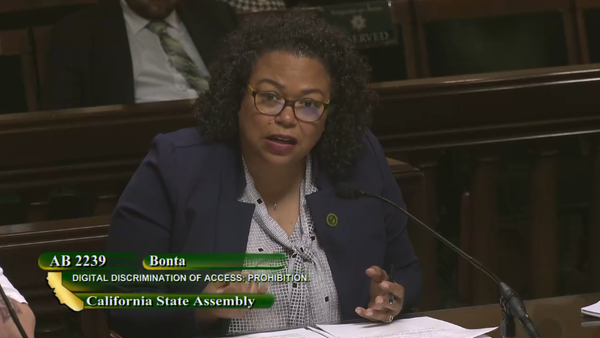BroadbandCensus.com Urges Public Broadband Map with SPARC Scores
WASHINGTON, June 11, 2009 – In comments filed before the Federal Communications Commission, BroadbandCensus.com said that basic broadband data — information about the speeds, prices, availability, reliability and competition of local service — is not proprietary and should be part of a public and tr
In Federal Communications Commission Filing, BroadbandCensus.com Urges Transparency in Identifying Speeds, Prices, Availability, Reliability and Competition in Broadband Marketplace
‘A National Broadband Plan Must be Accompanied by a National Broadband Mashup’
Press Release
WASHINGTON, June 11, 2009 – In comments filed before the Federal Communications Commission, BroadbandCensus.com said that basic broadband data — information about the speeds, prices, availability, reliability and competition of local service — is not proprietary and should be part of a public and transparent national broadband database.
The comment, filed by BroadbandCensus.com Executive Director Drew Clark, said that the FCC should take a two-fold approach to broadband data as part of its national broadband strategy. First, the FCC should publicly release the basic broadband data collected from broadband carriers by the agency. This basic data should include the carriers that operate within each Census Block, together with the speeds and technologies that they offer.
Second, whether or not the FCC releases this basic, public data, the agency should take a consumer-focused approach to broadband data by encouraging efforts to independently collect broadband data from consumers, rather than merely relying on broadband providers. This latter approach will allow internet users to independently verify carrier data.
The resulting publicly-available repository of broadband data will include many layers of data: consumer data, government data, data from carriers who choose to “opt-in” and have their broadband information included in the repository. The repository would form the basis for the national interactive broadband map that is called for by the American Recovery and Reinvestment Act. On it, each of these layers can either checked be or unchecked in a particular interactive display.
“BroadbandCensus.com believes that carrier-supplied data must be cross-checked against a multiplicity of sources that are independent of broadband carriers,” according to the comments. “Hence the need for granularity, for carrier specificity, and for public and freely available datasets. A National Broadband Plan must be accompanied by a National Broadband Mashup.”
BroadbandCensus.com is one entity that is taking an independent and “crowdsourcing” approach to broadband data. BroadbandCensus.com calls this approach the Broadband SPARC: Speeds, Prices, Availability, Reliability and Competition.
As BroadbandCensus.com explains within its comments:
In addition to collecting data about speed, price and competition, the public and transparent crowdsourcing approach to collecting broadband data enjoys several additional benefits. The BroadbandCensus SPARC Score is a metric evaluating the Speeds, Prices, Availability, Reliability and Competition within any particular geography. The Broadband SPARC Score becomes a tool for comparing broadband deployment between states, between counties, between cities, between ZIP codes, or between even finer degrees of geography. The Broadband SPARC Score allows public and private entities seeking to utilize federal broadband stimulus funds to compare the state of their geographies – and the impact that their stimulus-funded efforts have on broadband. Does a particular Census Block, Census Block Group, or Census Tract have a low Broadband SPARC Score before stimulus funding? Measuring the SPARC Score after the deployment of new stimulus funding – either for broadband networks (“supply side”) or for broadband applications and education campaigns (“demand side”) – would provide tangible, quantitative evidence of an impact for the government’s broadband investments.
[…]
The advantage of the consumer-focused approach to collecting and publishing broadband data is that it allows the consumer information from the Broadband Census to be incorporated into a publicly available repository of information – into which carrier information may also be added. The interactive map generated by the publicly-available data will be layered in all of its dimensions: Speed (including broadband technology, like DSL, cable, wireless), Price, Availability, Reliability, Competition (including individual carriers). Consumers will be able to click on and click off those variables most pertinent to their situation. Equally significant is that carriers will have the opportunity to “opt-in” to the public display of data about the areas in which they provide broadband service, as well as to their promised speeds and prices. Because the consumer data on BroadbandCensus.com is constantly being updated through individual broadband census entries and through individual speed tests, the “map” generated by the underlying data will likewise be constantly refreshed.
About BroadbandCensus.com
BroadbandCensus.com is an independent provider of news, information and events about broadband technology and internet policy. A for-profit company, BroadbandCensus.com is dedicated to providing independent reporting and insightful analysis about the role and status of broadband in the economy and in society, and is at the forefront of understanding and explaining the implementation of the $7.2 billion broadband stimulus package on the federal, state and local level.
As a news organization, BroadbandCensus.com takes no position on substantive telecommunications policy controversies, such as network neutrality, universal service, video franchising, or media and spectrum concentration. BroadbandCensus.com does, however, firmly believe in the value of transparency, both as a means to oversee the government, and to provide consumers with recourse vis-à-vis their broadband carriers.
A copy of the comments is available on the FCC website or on BroadbandCensus.com.







